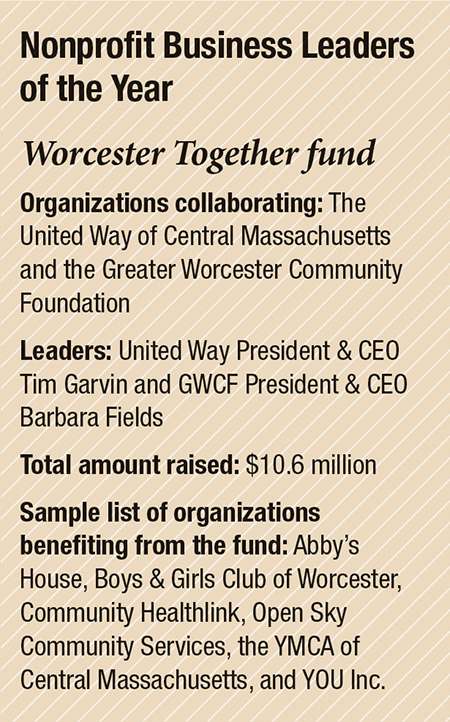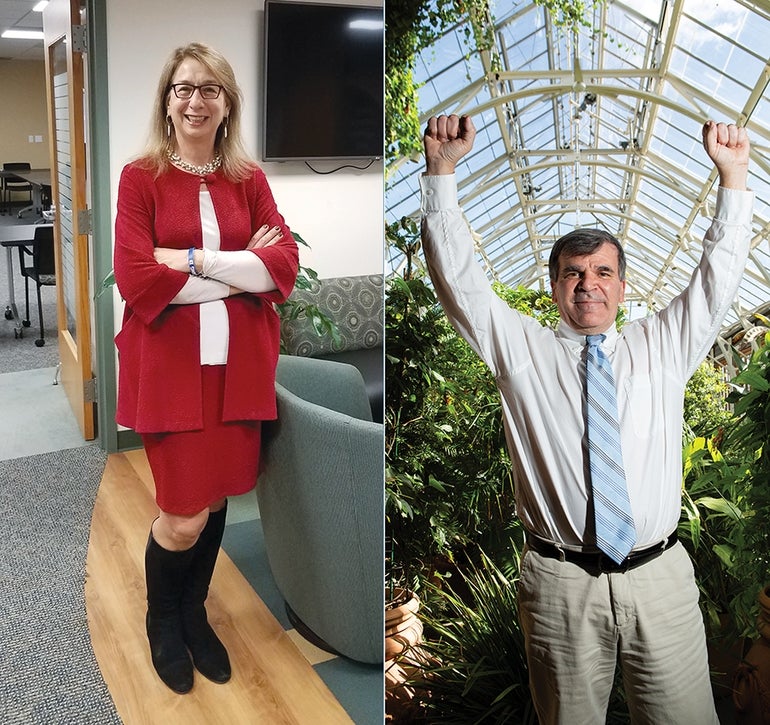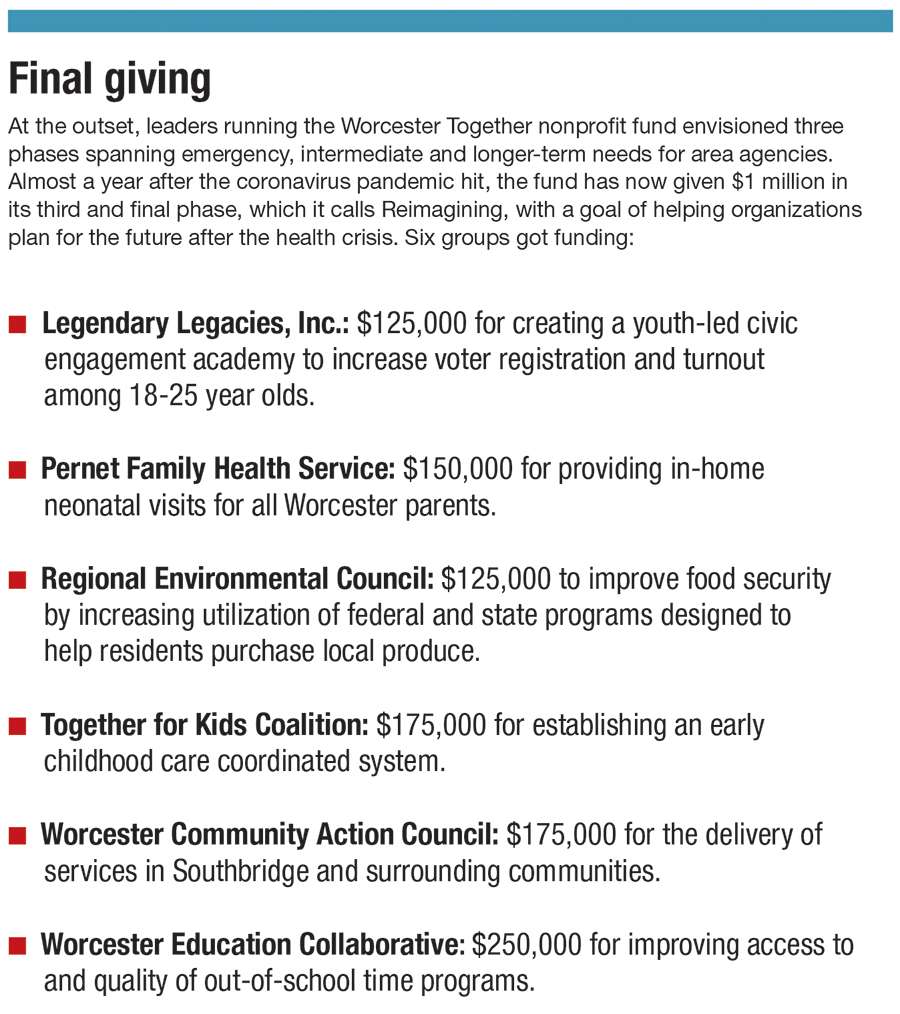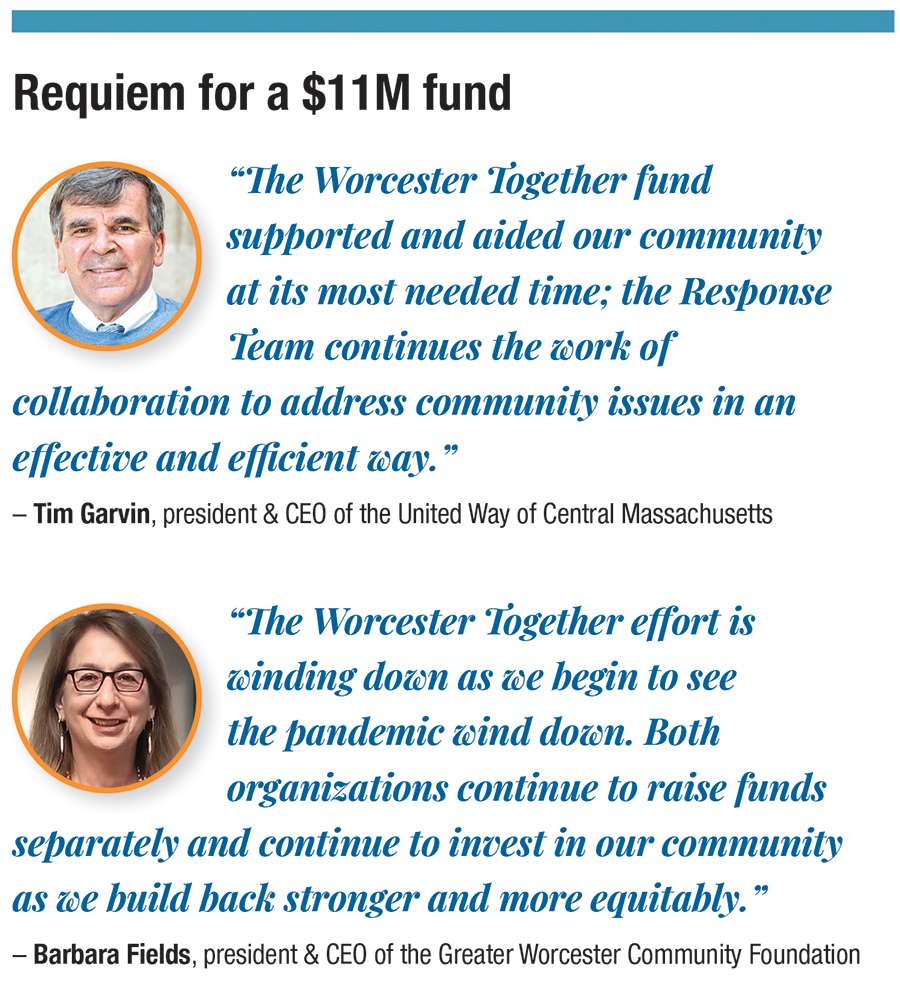
Business Leader of the Year: Worcester Together came to the rescue
 Photos | Brad Kane & Matthew Wright
Barbara Fields (left), president & CEO of the Greater Worcester Community Foundation, and Tim Garvin, president & CEO of the United Way of Central Massachusetts
Photos | Brad Kane & Matthew Wright
Barbara Fields (left), president & CEO of the Greater Worcester Community Foundation, and Tim Garvin, president & CEO of the United Way of Central Massachusetts
A lot of people and businesses needed help, and agencies were eager to react. Plenty of donors were willing to pitch in.
Bringing the two together wasn’t so easy in the early days of the coronavirus pandemic, but the leaders whose efforts eventually became the Worcester Together fund quickly had to match needs with giving during a time when a health crisis was moving so fast that little time could be wasted.

From late winter 2020 through July, the fund had undoubtedly succeeded expectations, with more than $10 million raised, much of it going to dozens of organizations in and around Worcester, for both the most immediate needs such as food and housing, to more intermediate needs and planning agencies would need as the pandemic went on.
“Never in my wildest dreams did I think we’d get to $10 million,” said Tim Garvin, the president and CEO of the United Way of Central Massachusetts. “But it’s always been like this: Central Massachusetts and Worcester have always stepped up in ways that we can’t imagine, yet if we look back, it always does.”
The United Way was one of two agencies leading the initiative, along with another group with close and longstanding ties to area organizations: the Greater Worcester Community Foundation. Almost a year ago, both groups separately began fundraising efforts when it became apparent the pandemic would lead to significant needs, from youth programs and senior care to badly needed technology help for students and hot food for those who were homebound.
At GWCF, President and CEO Barbara Fields reached out to her executive committee on a Sunday in the middle of last March with a request: could the foundation make an exception to its usual guideline of spending no more than it took in through donations and investments? That typical way of doing business would mean the foundation could spend about 4% of its funds each year, but Fields wanted to bump that to 5% while needs were so great.
The difference would mean almost an extra $500,000, and the foundation could start a pandemic response fund. Fields was approved. Before going public, she reached out to the United Way and other partners. Garvin told her the United Way was working on a fund, too.
At the United Way, Garvin reached out to his board with an idea for something called the We Care Fund. It would be a play on the United Way’s initial fund, called Supposed Nobody Cared. Garvin sent an email at 6:23 that same Sunday morning and soon after went to grab his wallet to make the first donation himself. By 7 o’clock, 10 members had already donated, he said.
Within a few days, it became increasingly obvious to leaders of both GWCF and the United Way it would make the most sense to combine their efforts. That way, coordination of collecting donations and doling out money would be simpler and quicker. By late March, the Worcester Together fund was on its way.
“I talked to community foundations across the state and no one had a relationship with the United Way like this,” Fields said. “We’re very fortunate.”
The fund’s leaders count themselves as fortunate for having immediate and strong support from businesses, individuals and philanthropic organizations. The Worcester-based George I. Alden Trust, for example, gave $1 million very early on. Many seemed more eager to give financially, Garvin said, because they weren’t exactly able to lend a hand in person during a pandemic.
In those first weeks, Fields and Garvin held daily calls with Worcester City Manager Edward Augustus to review applications. When considering whether to provide funds to an agency, a quick ability to get help to where it was needed was a top priority.
“The question was, ‘Who could really deliver in that first phase?’” Fields said.
That first phase included the bulk of the fund’s giving at $6.3 million, with dozens of recipients.
Abby's House, which operates a homeless shelter, got funds to make sure it could stay staffed and operational. Community Healthlink got money for a specialized residence for coronavirus-positive patients who needed special attention. One early donation, Garvin said, was incredibly useful despite how mundane it may seem: mobile showers for the homeless.
“The most unglamorous but most incredibly useful grant,” Garvin said.
A second phase totaled $2.3 million, meant to help organizations with less-immediate needs and more on their own survival. A third phase includes $1 million to help agencies reimagine their operations in 2021 and beyond, Fields said, including structural societal issues they’re working toward improving.

The YOU Inc. Family Resource Center, part of the Worcester nonprofit Seven Hills Foundation, received funds to cover a program delivering hot meals to the homes of those who were isolated or in quarantine. It also started a program with the Boys & Girls Club and the Massachusetts Department of Children and Families to train older children to babysit younger siblings not in school.
The Family Resource Center had a close relationship with the United Way from when the two worked together on Hurricane Maria aid in 2017, said Emily Swalec, the site director for the Family Resource Center. The scale of need during the pandemic has been so great, she said, including for child care, food insecurity and rent aid.
“The circumstances would be so much worse if these resources didn’t exist,” Swalec said.
Another beneficiary, the YMCA of Central Massachusetts, also had longstanding ties with both the United Way and GWCF. The Worcester-based Y received $243,000 to support emergency child care, summer programs and financial resources for the Y’s recovery plan.
“Record unemployment, staggering food insecurity rates, and devastating gaps in education delivery have left local families in desperate need,” said David Connell, the Y’s CEO.
With Worcester Public Schools students learning remotely this year, the Y turned its branches into learning homes. It created a home meal delivery program for children and provided full-day child care for parents still going into work.
“I believe the strength of our response directly correlates to coming together for the greater social good,” Connell said of the Y’s efforts and the Worcester Together fund work more broadly.

Roughly a year after the fund’s start, those who helped lead the efforts look back with gratitude and amazement at how quickly and effectively they were able to raise and dole out more than $10 million during the crisis.
“No one could have predicted the pandemic,” Fields said, “but no one could have predicted the response, either.”
Chief among the less-tangible benefits, Fields said, were the strengthened partnerships in many cases or, in some cases, new partnerships where they didn’t exist before.
Garvin evoked Charles Dickens to similarly laud the way area groups worked together at a critical time.
“It’s the worst of times, but the best of times for Worcester collaborations,” he said. “I’ve never been prouder of this city and the way that people came together.”









0 Comments